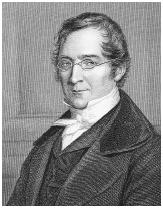Joseph-Louis Gay-Lussac
FRENCH CHEMIST AND PHYSICIST
1778–1850
Joseph-Louis Gay-Lussac was one of the great scientists of the industrial age. Born on December 6, 1778, in St. Léonard in central France, he was the eldest of five children. His father was a public prosecutor and judge advocate, and the political unrest surrounding the French Revolution played an early role in young Joseph's development. When his father was arrested in 1794 (he was later released) as a member of the bourgeois establishment, Gay-Lussac was sent to a boarding school in Paris.
Three years later Gay-Lussac was accepted to the newly founded and elite École Polytechnique in Paris, where he initially studied mathematics and engineering. However, he soon fell in love with science and especially chemistry. This was in no small part due to the influence of the renowned scientist Claude-Louis Berthollet (1748–1822), a lecturer at the École who was also a contemporary of Antoine Lavoisier. It was Berthollet who took Gay-Lussac under his wing as his student and laboratory assistant.
The research for which Gay-Lussac is perhaps most famous involves the experiments with gases he completed early in his scientific career. Upon graduation from the École in 1800, he remained Berthollet's assistant and a frequent guest at his country house at Arcueil, near Paris. With the encouragement of Berthollet, mathematician Pierre-Simon de Laplace, and others, Gay-Lussac began his own research in the winter of 1801 and 1802.

Among Gay-Lussac's early work was an extensive investigation of how the volume of various gases changes with temperature. The English scientist John Dalton was independently studying the same phenomenon. Both found that the volume V of all gases studied increased similarly with higher temperature T when pressure P was held constant ( VαT at constant P ). Each published his results around 1802, with Gay-Lussac's experimental work being both more thorough and more precise than that of Dalton. However, the credit for this discovery typically goes to neither Dalton nor Gay Lussac, but instead to Jacques Charles. Charles had done some initial work on the thermal expansion of gases in 1787. Although Charles never published the results of his experiments, in his own scientific memoirs Gay-Lussac acknowledged hearing of Charles's work. Thus, the law governing the thermal expansion of gases, while sometimes called Gay-Lussac's law, has come to be known largely as Charles's law.
Gay-Lussac's studies were not limited to the physical properties of gases. In 1804 Gay-Lussac took advantage of the world's growing interest in ballooning and made multiple flights to study both Earth's magnetic field and how the temperature and composition of the atmosphere changed with increasing altitude. On his second flight, he took samples of air while reaching an altitude of 23,018 feet in a hydrogen balloon, a record that lasted for almost fifty years. Upon his return to Earth, he compared the gas samples to those taken at ground level and concluded that they were essentially identical—this despite making note of a headache during the flight that very possibly resulted from the decreased oxygen levels at high altitude.
In 1808 Gay-Lussac published his "Law of Combining Volumes of Gases." He determined that when different gases reacted, they would always do so in small whole number ratios (e.g., two volumes of hydrogen would react with one volume of oxygen in forming H 2 O). This was one of the greatest advancements of its time and helped form the basis for later atomic theory and how chemical reactions occur.
With his colleague Louis-Jacques Thénard (1777–1857), Gay-Lussac did considerable work with electrochemistry to produce significant amounts of elemental sodium and potassium, highly reactive and useful substances that were used to isolate and discover the element boron. Gay-Lussac also completed extensive studies of acids and bases and was the first to deduce that there were binary (two element) acids such as hydrochloric acid (HCl) in addition to the known oxygen-containing acids like sulfuric acid (H 2 SO 4 ). Additionally, he was able to determine the chemical composition of prussic acid to be hydrocyanic acid (HCN) and was considered the foremost practitioner of organic analysis.
In later years, Gay-Lussac continued to advance science. He developed a precise method for analyzing the alcoholic content of liquors and patented a method for the manufacture of sulfuric acid. His last publication on aqua regia (a mixture of nitric and hydrochloric acids that dissolves gold or platinum) came out the year before his death in 1850. Gay-Lussac was a topnotch experimentalist and theoretician. More than twenty-five years after Gay-Lussac died, the prominent chemist Marcellin Bertholet (1827–1907) once said, "We all teach…the chemistry of Lavoisier and Gay-Lussac" (Crosland, p. 248), a fitting tribute to two outstanding scientists of the era.
SEE ALSO Acid-Base Chemistry ; Berthollet, Claude-Louis ; Charles, Jacques ; Dalton, John ; Davy, Humphry ; Lavoisier, Antoine .
David A. Dobberpuhl
Bibliography
Arago, François (1855). "Oeuvres Complètes de François Arago." In Great Chemists, tr. and ed. Eduard Farber (1961). New York: Wiley-Interscience.
Crosland, Maurice P. (1978). Gay-Lussac, Scientist and Bourgeois. Bristol, U.K.: Western Printing Services.
Comment about this article, ask questions, or add new information about this topic: